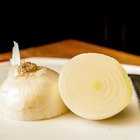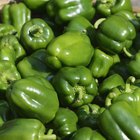
Chopped raw onions produce tears because the knife causes cell damage in the onion, releasing sulphuric gas. That sulphuric gas emitted from the onion reacts with tear ducts, irritating the eye and causing crying. Heating the onion prior to chopping it denatures, or breaks apart, some of the enzymes that cause the release of the sulphuric gas, helping keep the tears at bay. Knowing how to heat an onion so you don't cry may help make the antioxidant-rich vegetable a staple in your kitchen and cooking.
Step 1
Wash the onion and place it on a microwave safe dish. Pierce the onion all over its surface with a fork immediately before placing it in the microwave. Piercing the onion will release some of the gas so minimize contact with that by putting it in the microwave immediately and closing the door.
Step 2
Heat the onion on medium (50 percent) heat for 30 seconds. The enzymes in the onion start to denature at 158 degrees Fahrenheit -- check the temperature using a kitchen thermometer. Continue to cook at medium power in 30-second increments until the onion's internal temperature reaches 158 F.
Step 3
Cool the onion to room temperature before peeling and cutting. Use a sharp knife and remove the root end last to avoid releasing any residual gasses.
Related Articles

Nutrition Information for an Onion

How to Blanch Onions

How to Get Rid of Onion Stings

Juicing An Onion

How to Make Onion Extract

How to Caramelize Onions in the ...

How to Mince an Onion

How to Microwave Vidalia Onions

How to Sauté Onions

How to Eat Wild Onions

How to Easily Peel the Skin Off a Pearl ...

Does Too Much Onion Affect Your Memory?

How to Soak Onions in Salted Water

How to Grate Carrots

Granulated Onion vs. Dried Chopped Onion

What Are the Health Benefits of Cooked ...

Blanching An Onion

How to Boil Tomatoes

How Do I Blanch Green Peppers?

How to Freeze Onions for Future Use
References
- The America's Test Kitchen Family Cookbook; Jack Bishop
Resources
Tips
- Because the onion will be partially cooked after this heating process, reduce the amount of time to cook it in the recipe, adding it at the end if possible, to avoid overcooking.
- In the absence of a microwave, simmer the onion without piercing it in a pan of water on the stovetop until it reaches 158 F.
- When pre-cooking the onion doesn't work for your recipe, try chopping it under running water to whisk away some of the sulfuric compounds before they reach the air.
Warnings
- Wear gloves or wash hands thoroughly after handling onions to avoid transferring the irritating oils to your eyes.
Writer Bio
Andrea Lott Haney writes articles and training materials for food industry publications. Having studied foodservice sanitation, nutrition and menu planning at Purdue University, Lott Haney has more than 10 years of experience as a catering and event planner for luxury hotels and currently tours the Midwest as a corporate customer service trainer and consultant.
Photo Credits
Martin Poole/Digital Vision/Getty Images